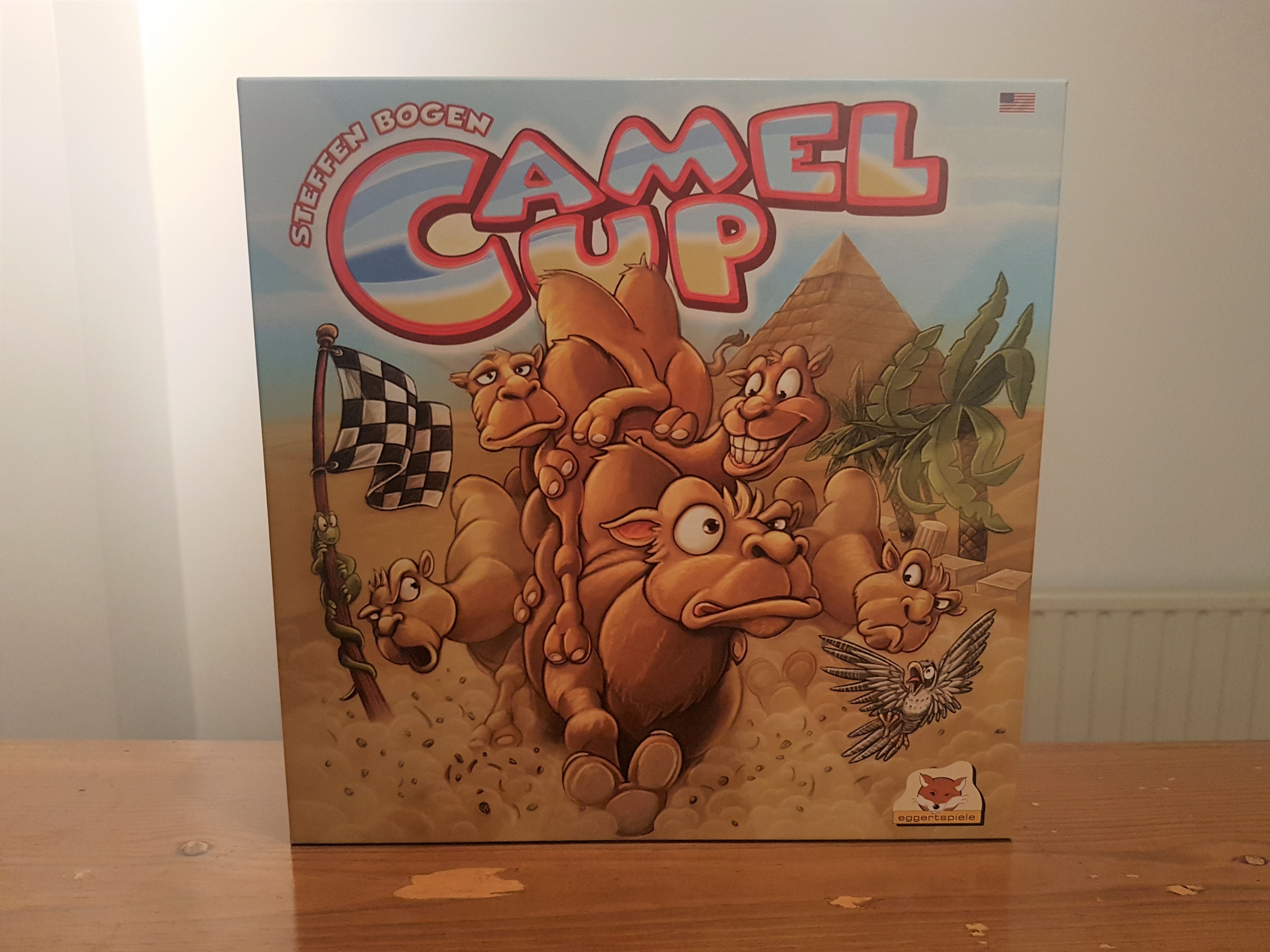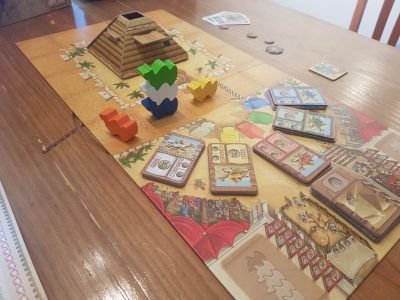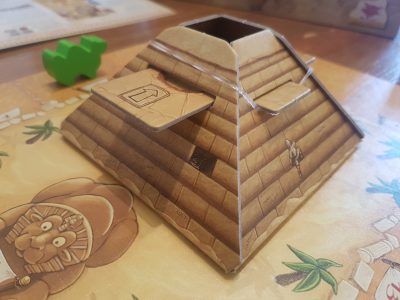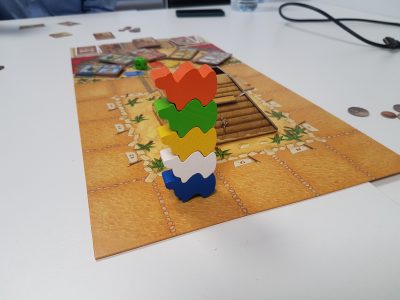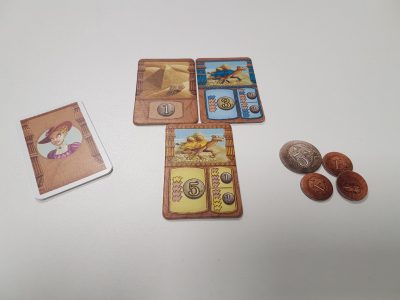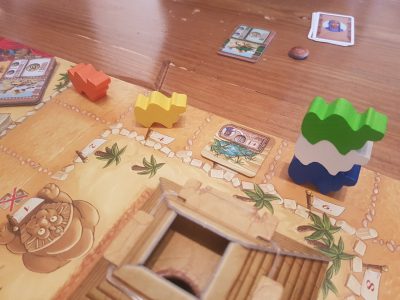Camel Up, sometimes referred to as Camel Cup, is a family friendly betting game from designer Steffen Bogen. The games sees 2 – 8 players betting on a camel race and it’s rounds, with the whole race lasting around half an hour. Wrapped into the race is dice rolling and minor ways to manipulate the movement of the camels. However, is this a thematic camel race full of fun or does luck wash the enjoyment away? Let’s find out.
Players will start off with 3 Egyptian Pounds, 5 camel cards that represent the five coloured camels and a desert tile. To set the board up the leg betting tiles are sorted into colour and ranked highest to lowest based on their coin return. The five coloured dice are rolled to give a starting order for the 5 camels and are then returned into the pyramid. The game is then ready to play, with the aim to earn the most money by betting on the camels across the legs of the race and it in its entirety.
On a turn players have a total of four actions available to them, though they can only do one. These actions are: Take a pyramid tile, take a leg betting tile, place a desert tile or bet on the overall winner/loser. The 3D pyramid players construct isn’t just a visually awesome use of cardboard it also doubles up as a dice roller. Taking a pyramid tile allows the player to press the mechanism on the pyramid so that one die drops out. The colour of the die makes the respective coloured camel move the number of spaces on the die.
This is when the “Up” part of the title comes into play. Camels on the same space stack upwards, with the top-most camel in the lead. When a top camel, or one on its own, move they simply move along the race track. However, when a camel in the middle or bottom of a stack of camels is made to move they take all the camels stacked above with it. This can see camels moving twice or more on a single turn, allowing the race order to change drastically.
After a bit of camel movement players might start to think they know which one will end up in the lead at the end of the leg. This is the ideal time to take a leg betting tile. The top leg betting tile will net the player 5 coins if the camel comes in first or 1 coin if that colour camel is in second. Alas, the player instead will lose 1 coin if it comes in outside the top two. Once the tile is taken the odds are slashed for that camel with the next time only offering 3 coins if that coloured camel comes in first. Each camel only has three tiles. These can run out and individual players can even choose to take as many as they want during a round.
Placing a desert tile will affect the movement of the camel units that land on it. With two sides an oasis and a mirage, once placed if a camel unit lands on the tile they go forward or back one space respectively. On top of this the owner of the tile gains a coin each time it happens. The final action is rarely taken in the first round and involves placing a coloured camel card from your hand onto the overall winner or loser zones. Why would you want to bet early? The earlier you correctly guess the winner or loser of the whole race compared to the other players the more coins you’ll receive.
Play continues around the table until all five dice have been rolled from the pyramid. At this point the leg is over and some money will be paid out by the bank. Firstly, for every pyramid tile a player took during the round they gain a coin. Next, leg betting tiles are determined to be winning or losing and paid accordingly. Desert tiles are returned to their owners, the leg betting tiles are restacked, the dice are returned to the pyramid and a new leg starts.
This round based system keeps going until a camel has crossed the finish line, instantly ending the race. Before final betting is calculated the leg bets and tokens are paid out as normal, then the overall bets are revealed. Wrong bets lose the player a coin but being first to correctly guess either the overall winner or loser can score a player 8 coins, enough to comfortably swing victory their way if others guess incorrectly. Coins are totalled by players and the richest camel predictor wins!
Camel Up is an extremely quick game to play often with only 3 legs of the race. The box suggests 20 – 30 minutes for a game, with the later being the case at a high player count or when including teaching the game. Initially the camel stacking and movement can confuse those new to the hobby, it isn’t exactly normal camel behaviour. After only a couple of turn everything will have clicked and the entertainment will start to flow.
The desert tiles can drastically speed up the game if units of camels consistently land on oasis tiles. As the dice have a maximum of 3 on them without the oasis tiles you could potentially get an entire other leg in the race. At the same time, the mirage tiles could slow the race down by bouncing camel units back a space. Instead, these are often used to make a particular camel lose the overall race rather than stop obvious front runners. Players seem to judge securing one correct prediction more important, even if everyone bets the same.
Regularly players will have tried out racing games where they control one or more of the race entrants, some have even played Downforce where you have a car and bet on the winner. Conversely, most of the players that have tried out Camel Up haven’t previously played a purely betting game. It’s an interesting take on a race that is surprisingly light-hearted, despite effectively imitating gambling on a horse race.
The fun, cartoony theme does help the game to start on the right side of the family friendly line. The coloured camels which stack up on top of one another set the board off to be vibrant and appealing to even those whom would steer clear of any gambling in real life. There are some flair details on the game board and pyramid which highlights the game is just for fun and shouldn’t be taken seriously. Such details include the entertaining winner and loser camel pens, which sees a podiumed camel and a cartoony exhausted camel. Wrapping the game up into a thematically awesome bundle is the dice roller pyramid that sits in the centre of the racetrack. It gives the board a vertical visual pop, that works incredibly well at drawing in people to ask to play the game.
When unboxing the game, I had some reservations with the use of a rubber band as part of the dice rolling pyramid. Instantly it was flagged in my head as a weak spot of the components, able to break via over use. Thankfully, the designer has gamers in mind and has included additional rubber bands in to box. Not only does this help to settle my mind about the longevity of the game surviving many, many plays but shows that thought has been put in about potential problems. It is nice to see a designer proactively addressing an issue before the problem truly arises.
Camel Up is a thoroughly enjoyable family themed betting game. It seems like that statement should be a contradiction, mixing gambling with family members of any age is surely a recipe for disaster yet the cartoony, colourful style saves the day. There is something strangely exhilarating about seeing the camel you’re betting on stack on top of another camel, as often it’ll see it travel further in the leg. The game engages players and entertains them making them come back for more. Camel Up won’t be keeping seasoned gamers engrossed for hours on end. Nevertheless, to break apart heavy games on a game night this board game certainly steals the camel cup!
[Editor’s Note: Camel Up was provided to us by Esdevium Games for review purposes. The game is currently available on 365 Games for £21.99. It is also available from local UK board game stores, find your local store here]

